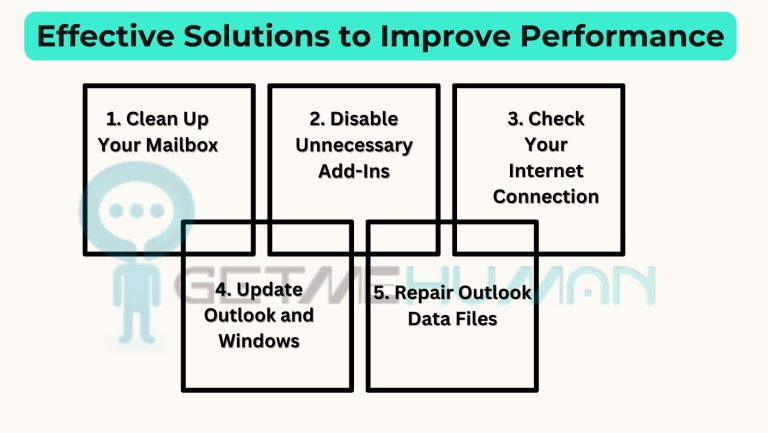Outlook Running Slow or Lagging: Handling Tips and Solutions

Microsoft Outlook is an essential tool to handle calendar and emails. Many users face the frustrating issue of Outlook running slow or lagging.This article covers common causes why your Outlook experience doesn’t function as smoothly as it could and provides solutions to get your application back on track.
Understanding Why Outlook is Running Slow or Lagging
When users experience Outlook running slow in lagging, it can significantly disrupt their workflow. Understanding why Outlook is running slow or lagging involves examining common issues. Here are a few issues that can contribute to the slowdown.
1. Large Mailbox Size
Many users face difficulties with email syncing across devices, leading to missed messages and outdated information. These Microsoft Outlook issues can be particularly frustrating.
2. Excessive Add-Ins
Whereas add-ins could enhance performance, a lot of them can make Outlook lag or work slowly. Performance can suffer from plugins that drain system resources in the background.
3. Network Connectivity Issues
Check your internet connection if Outlook is lagging or running slow. The app might seem sluggish overall due to pauses in mail sending and receiving due to a slow or insecure network.
4. Outdated Software
Using an outdated version of Outlook may cause problems with performance. Regular updates often enhance speed and fix issues, hence not updating your software can contribute to Outlook running slow or lagging.
5. Corrupted Data Files
Another common cause of Outlook running slow, or lagging is corrupted PST or OST files. If these files become damaged, it can significantly hinder performance.
6. Background Processes
Outlook could slow down, or function slow as a result of other programs consuming up CPU and memory resources. You must keep an eye on the workings of your system to identify any programs that are affecting.
Effective Solutions to Improve Performance

When dealing with Outlook running slow in lagging, it’s essential to implement effective solutions to improve performance. Users can enhance their overall productivity and restore Outlook by addressing the main reasons for slowness. Each of the methods listed below may help in solving these common problem areas.
Read Also: Microsoft Outlook Issues 2024
1. Clean Up Your Mailbox
One of the best ways to address Outlook running slow in lagging is to clean up your mailbox. Delete useless emails and large attachments on a regular schedule. Here are some steps:
- Archive Old Emails: Put previous emails in an archive folder.
- Empty Deleted Items: Delete items from your folder on a regular basis.
- Use the Cleanup Tool: Go to File > Tools > Mailbox Cleanup to manage mailbox size effectively.
2. Disable Unnecessary Add-Ins
If your Outlook is running slow or lagging, disabling unnecessary add-ins can help. To do this:
- Navigate to File > Options > Add-ins.
- At the bottom, select COM Add-ins and click Go.
- Uncheck any add-ins that you don’t use frequently and click OK.
3. Check Your Internet Connection
If Outlook running slow or lagging, a poor internet connection could be the culprit. For the best results, make sure your connection is stable and consider using a wired connection.
4. Update Outlook and Windows
Updating your program can greatly improve performance. To check for updates:
- For Outlook, go to File > Office Account > Update Options > Update Now.
- For Windows, navigate to Settings > Update & Security > Windows Update.
5. Repair Outlook Data Files
If you think that Outlook is running slowly because of damaged files, you can fix them with the built-in tool:
- Close Outlook.
- Open the Control Panel and select Mail.
- Click on Data Files, select your file, and click on Open File Location.
Use the Scanpst.exe tool found in the Outlook installation directory to repair your file.
6. Optimize Background Processes
To conflict Outlook running slow in lagging, manage your background processes:
- Close Unnecessary Applications: Shut down apps you’re not using.
- Check Task Manager: Use Ctrl + Shift + Esc to open Task Manager and identify resource-heavy processes.
7. Manage Your Calendar
A mixed calendar can also lead to Outlook running slow or lagging. Remove old or useless events and limit the number of shared calendars you have.
8. Adjust Outlook Settings
For instance, settings in Outlook can contribute to performance issues. Consider these adjustments:
- Disable Animations: Go to File > Options > Advanced, and under Display, uncheck Provide feedback with animation.
- Enable Cached Exchange Mode: For Exchange accounts, enabling Cached Exchange Mode can improve responsiveness.
9. Upgrade Your Hardware
If your computer is struggling to keep up, consider upgrading:
- Increase RAM: More RAM can enhance overall performance.
- Switch to an SSD: Upgrading to a Solid-State Drive (SSD) can significantly reduce loading times for all applications, including Outlook.
10. Reinstall Outlook
If Outlook continues running slow or lagging despite troubleshooting, consider a full reinstall. This can let you start over and solve worse software issues.
Conclusion
Experiencing Outlook running slow or lagging can be a frustrating obstacle in your daily tasks. However, by identifying the common causes and implementing effective solutions, you can restore Outlook’s performance. Regularly cleaning up your mailbox, disabling unnecessary add-ins, and keeping your software updated are essential steps in preventing sluggishness. With these tips, you can enhance your Outlook experience and improve your productivity while using the Outlook Email Service.
